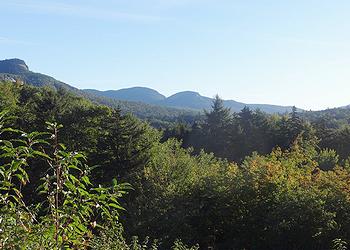
By Martin Laine
CONCORD, New Hampshire, May 5, 2014 (ENS) – The U.S. Department of Energy has released a list of alternatives under consideration for the controversial Northern Pass transmission line project in New Hampshire. The choices range from scrapping the plan altogether to burying the entire power line underground.
The alternatives list comes in advance of the DOE’s environmental impact statement, due to be issued later this year. The list issued Friday was compiled from recommendations received during the public comment period last year.

Northern Pass is the name given to a proposed 1,200 megawatt transmission line that would carry hydroelectric power generated from dams in Canada through 187 miles of New Hampshire and add that electricity to the New England power grid.
It is a joint venture of three private companies: Northeast Utilities, Public Service of New Hampshire, and Hydro-Quebec.
The $1.1 billion project has provoked controversy ever since the original plan was unveiled in 2011.
The original proposal calls for cutting a 40-mile long, 100-foot wide swath through the scenic White Mountains, a tourist mecca. The lines would be supported by a series of pylons ranging from 85 feet to 135 feet in height, dominating the landscape.
Proponents – mostly from the business community – say it will bring much-needed jobs to the region, additional tax revenues, and environmentally-friendly energy.
Opponents, made up of a coalition of residents, as well as conservation and environmental organizations, are particularly concerned about the route of the transmission line.

The Society for the Protection of New Hampshire Forests opposes the 1,500 planned pylons, saying they would create “a 187-mile scar across two-thirds of our state.”
The transmission line would impact three of the society’s Forest Reservations, dozens of conservation easements, and the White Mountain National Forest.
Opponents also point out that the jobs are only temporary, and that the power will mostly be distributed outside of New Hampshire.
Many say that if the project is to go through, the lines should be buried underground.
The New Hampshire legislature recently gave its support to this idea when it passed a bill requiring that all new utility lines in the state be buried underground.
The Northern Pass developers did modify their plans, offering to bury an eight-mile length of the line, but this did little to mollify opponents.
The developers argue that burying the lines is prohibitively expensive. Running the lines on pylons above ground costs roughly $3 million per mile, while the cost of burying the line is $15 to $20 million a mile, according to Northern Pass spokesperson Lauren Collins.
While the list issued Friday outlines 21 alternatives, it gives no indication of what the Energy Department’s final recommendation may be. However, both sides say they are pleased to see the range of alternatives being considered.
Among the alternative plans now under consideration are several that would involve burying all or large portions of the transmission line, and at least one major route change.
See a map of the proposed route on the Northern Pass website at: http://www.northernpass.us/assets/state_route%20map%208.5x11_8-28-13.pdf
One alternative would bury the entire length of the line along the original route – from the Canadian border that divides Chartierville, Quebec from Pittsburg, New Hampshire to a converter station at Franklin.
Another would follow the original route, burying only the 40-mile portion that runs through the White Mountain National Forest.
Still another would also bury the entire line, but it runs along a different route, using existing roadways.
Jack Savage, spokesman for the Society for the Protection of New Hampshire Forests, said, “One can read from the tea leaves that this thing is headed toward far more burial than they are proposing.”
The society has teamed with the Appalachian Mountain Club and the Conservation Media Group, a nonprofit group of filmmakers and conservationists inform more people in New Hampshire about these issues and has mounted a petition to Governor Hassan to bury or stop Northern Pass.
New Hampshire Governor Maggie Hassan said, “I am encouraged that the U.S. Department of Energy has heard the concerns of New Hampshire citizens and has agreed to examine a wide range of options on the proposed Northern Pass project, including several underground options.”
Copyright Environment News Service (ENS) 2014. All rights reserved.
